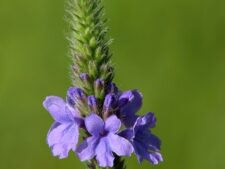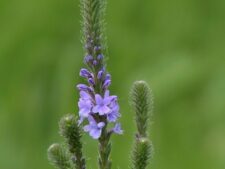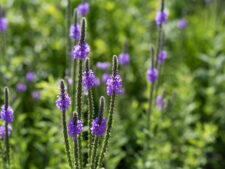
This native perennial has a square stem up to 4 feet tall. Opposite, coarsely toothed, oval, stalkless leaves are up to 4 inches long and 2 1/2 inches wide (A). Leaves are covered with dense, soft white hairs. One to several erect spikes of rose to purplish-blue tubular 1/4 inch flowers with 5 slightly irregular spreading petals occur at the top of the plant (B,C). Flowering proceeds from base to tip, the stalk elongating as new flowers appear (D). Each flower produces 4 nutlets hidden in the persistent calyx.
Grows on disturbed upland sites including overgrazed pastures, degraded prairies and roadsides, flowering from June through September. At Neale Woods, Hoary Vervain is common along roadsides; less common in some of the prairie restorations. It is present, although a bit less common at Fontenelle Forest.
Stalkless leaves covered with soft white hairs, rounded tips of flower spikes and preference for drier upland sites separate this plant from closely related Blue Vervain, (Verbena hastata).
This is a bitter-tasting plant avoided by livestock, often becoming abundant in overgrazed pastures.
Soft hairs on the leaves are responsible for the common name Hoary Vervain as well as alternate common names Woolly and Mullein-leaved Verbena.
The content of NatureSearch is provided by dedicated volunteer Naturalists of Fontenelle Forest who strive to provide the most accurate information available. Contributors of the images retain their copyrights. The point of contact for this page is: Neal Ratzlaff.

 Identification
Identification

